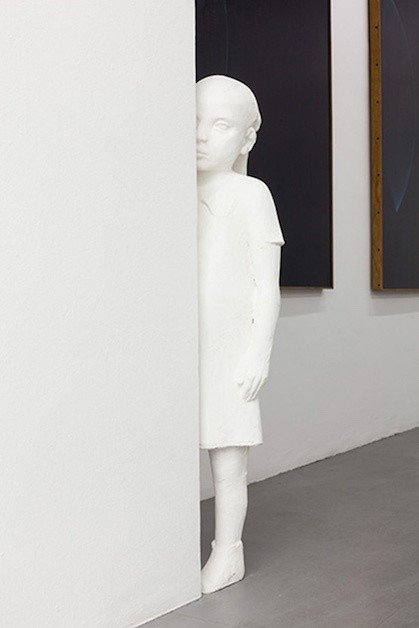Dominik Lang
A Girl with a Pigeon
08 Mar - 31 May 2017

Dominik Lang, "Girl with pigeon and its copies"
Ausstellungsansicht Krobath Wien 2017
Photography: Rudolf Strobl
Ausstellungsansicht Krobath Wien 2017
Photography: Rudolf Strobl
DOMINIK LANG
A Girl with a Pigeon
08 March – 31 May 2017
Dominik Lang’s development from his groundbreaking Sleeping City, presented at the 54th Venice Biennale in 2011, to A Girl with a Pigeon, presented 2015 at the Monash University Museum of Art, Melbourne,we need to highlight a difference in his handling of the estate of his father, Jiří Lang. Both projects centre on one sculpture – Jiří Lang’s modernist A Girl with a Pigeon from the late 1950s – but the approaches adopted in the two installations are distinct from one another. In Venice, the artist placed fragments of his father’s sculpture in two glass showcases, which when viewed from a certain angle allowed the work to be seen as an integral whole; in the Melbourne exhibition, he has joined the two parts in a single showcase, leaving the glass cube open (previously it was closed), so that the figure of the girl can descend into the exhibition space. The girl watches the pigeon from a distance. She feeds it. She looks for the bird as it escapes to the ceiling. She and the pigeon sit face-to-face at a table. They fall asleep together on a bed. The figure, originally seated, is used to produce the mould for several plaster casts in modified positions and with changes of gesture. We see the girl sitting, standing, kneeling, lying. We watch her, with her hands falling freely along her torso, with one hand behind her back, propped against a table, propped against the wall. Often the casts are split into segments: the hand, which the sleeping girl has under her head, is fragmented into three, and even the seemingly natural upright figure has a deep rift in her belly, a consequence of the ‘righting’ procedure. The disconsolate, moribund character of the girl with a pigeon is paradoxically complemented by the numerous casts. At first glance, the repetition and the spatial insulation of the plaster figures might remind us of minimalist works of the 1960s. Even though Lang presents us with figural works rather than ‘specific objects’, their significance – as in minimalism – has an outward bent and is co-constituted by the viewer.
Text: Karel Císař
A Girl with a Pigeon
08 March – 31 May 2017
Dominik Lang’s development from his groundbreaking Sleeping City, presented at the 54th Venice Biennale in 2011, to A Girl with a Pigeon, presented 2015 at the Monash University Museum of Art, Melbourne,we need to highlight a difference in his handling of the estate of his father, Jiří Lang. Both projects centre on one sculpture – Jiří Lang’s modernist A Girl with a Pigeon from the late 1950s – but the approaches adopted in the two installations are distinct from one another. In Venice, the artist placed fragments of his father’s sculpture in two glass showcases, which when viewed from a certain angle allowed the work to be seen as an integral whole; in the Melbourne exhibition, he has joined the two parts in a single showcase, leaving the glass cube open (previously it was closed), so that the figure of the girl can descend into the exhibition space. The girl watches the pigeon from a distance. She feeds it. She looks for the bird as it escapes to the ceiling. She and the pigeon sit face-to-face at a table. They fall asleep together on a bed. The figure, originally seated, is used to produce the mould for several plaster casts in modified positions and with changes of gesture. We see the girl sitting, standing, kneeling, lying. We watch her, with her hands falling freely along her torso, with one hand behind her back, propped against a table, propped against the wall. Often the casts are split into segments: the hand, which the sleeping girl has under her head, is fragmented into three, and even the seemingly natural upright figure has a deep rift in her belly, a consequence of the ‘righting’ procedure. The disconsolate, moribund character of the girl with a pigeon is paradoxically complemented by the numerous casts. At first glance, the repetition and the spatial insulation of the plaster figures might remind us of minimalist works of the 1960s. Even though Lang presents us with figural works rather than ‘specific objects’, their significance – as in minimalism – has an outward bent and is co-constituted by the viewer.
Text: Karel Císař
